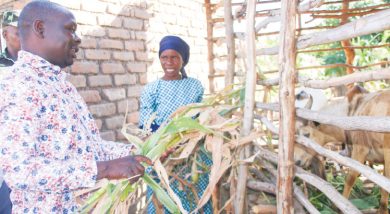Family planning myths, misconceptions
Jessie Dzama, 25, of Group Village Head (GVH) Mtende, Traditional Authority (T/A) Pemba in Salima believes that if a married couple sleeps under a treated mosquito net, they will not be able to conceive.
“It is a common belief in my community. People say if you are married and you keep on sleeping under a mosquito net, you will not bear children,” says Dzama.
On the other hand, 30-year-old Genereti Sadick firmly believes that modern family planning methods lead to barrenness.
As a result, Sadick, from Matumula Village, GVH Matumula in the same T/A, has eight children. She has been having a child every year ever since she got married at the age of 21.

Giving birth yearly has taken a toll on her health. But the misconceptions and myths associated with family planning make it had for her to use any modern contraceptive method that would enable her to space her child bearing.
Her two youngest children almost look like twins. The youngest, a boy, looks malnourished.
Dzama and Sadick are just examples of many women in the area of T/A Pemba who have been misled by misconceptions on use of mosquito nets and family planning.
But the two have since been enlightened.
“We have come to learn that mosquito nets don’t contribute to barrenness, but that they help prevent malaria transmission.
“I now have three children, all conceived under a mosquito net,” Dzama said.
Like Dzama, many people in GVH Mtende now know the importance of using mosquito nets to prevent malaria. This follows a community mobilisation project for the improved uptake of key Essential Health Packages (EHP) Services being implemented by Salima Aids Support Organisation (Saso).
Since April 2013, Saso has been implementing the EHP in T/As Khombedza, Pemba, Maganga and Kuluunda focusing on water and sanitation, HIV, Aids and tuberculosis, family planning, nutrition and malaria, among others.
The Saso EHP project’s goal has been to facilitate social and behaviour change that supports positive and sustainable changes among people of Salima District.
Dzama observed that in the past, due to the belief that treated mosquito nets contribute to barrenness, her family members were perennial victims of malaria since they had no alternative mechanism of controlling mosquito bites which cause the disease.
But after an interaction with Mtende Community Action Group (CAG) members through open meetings and home visits, Dzama and fellow villagers learnt how malaria is prevented, its signs and symptoms and vector management which cleared her misunderstanding and misconception.
Currently, Dzama, her husband and three children sleep under treated mosquito nets she received from a mass distribution exercise carried out by the Salima District Health Office.
“We sleep under mosquito nets every night and I am enjoying my sleep more than ever before,” she observed.
Dzama is currently one of the subjects of T/A Pemba supporting the Saso volunteers in dissemination of malaria messages to the community and encouraging fellow villagers to keep sleeping under treated mosquito nets.
Sadick, on the other hand, says she took her malnourished child to Maganga Health Centre where the medical personnel told her that the child was lacking nutritious food.
The nurse advised the mother to access the food for the child, but the mother said her family was too poor to access nutritious food.
But her problem was solved when she met Matumula CAG members under Saso’s EHP Services project, who were on a door-to-door family planning awareness visits.
The CAG members drilled Sadick on family planning and convinced her to adopt one of the methods if she was to live a healthy life and manage to take good care for her children. She has since done that.
CAG vice-secretary, Alice Saizi, wrote a letter for Sadick to hand it over to the health surveillance assistants (HSAs) working at a social Islamic development health centre in the area to provide her with Chiponde.
Following the letter, Sadick was assisted and provided with Chiponde for her child every Thursday.
From that moment, December 2015, Matumula CAG members have been visiting Sadick’s home every two weeks to monitor the child’s health.
“Currently, my child’s health has greatly improved. I, too, feel much better since opting for tubal ligation (a long-acting family planning method). I do not want any more children.”
Now, she says, she is able to engage in households chores and do farming activities.
According to Paul Duncan of Saso, the area of GVH Matumula had nine malnourished children before the introduction of the project under the supervision of CAG members. Currently, only two have malnutrition.
To achieve this goal, Saso developed objectives that included: Creating demand for comprehensive health services; increased community access to health services; enhancing equitable reach of services; addressing the underlying causes of health issues; and increasing community ownership and sustainability.
Saso has been working with Salima District Health Office, Ministry of Health, district executive committee (DEC), political leaders, community structures (local leaders, VDCs, VHCs,) area development committees, CBOs and Religious leaders as partners to achieve positive behaviour change towards EHP and start demanding the health services.
The project, which began in April 2013, has reached out to Salima’s population of 383 421.
Saso is implementing the project with funding from USAid through Social Services Delivery Integration (SSDI). n





